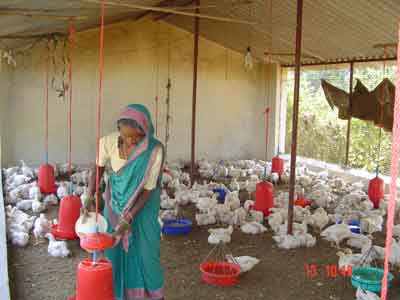Poultry, Food Security and Poverty in India: Looking Beyond the Farm-Gate
Jul 22, 2009
A Research Report of the Pro-poor Livestock Policy Initiative (PPLPI) of FAO, which draws upon some of the Good Practices documented by SA-PPLPP, looks at the multiple ways through which poultry sector development can contribute to increased food security and accelerated poverty reduction in Indiia.
'The argument in favour of poultry farming as a tool to increased food security and accelerated poverty reduction is that, since the majority of the poor keep some poultry birds and the demand for eggs and poultry meat is growing fast in the region, smallholders can sell their surplus eggs and poultry meat in the market and get a firm foothold on a ladder out of poverty. This line of reasoning is persuasive indeed, but, since it overlooks the indirect effects of poultry sector development on food security and poverty level – such as via employment generation in off-farm activities and lower prices for animal source food – it may lead to wrong policy targets and priorities. According to a Research Report "Poultry, Food Security and Poverty in India" of the Pro-Poor Livestock Policy Initiative (PPLPI) of FAO, in fact, (i) poultry farming and (ii) employment along the supply chain only represent a path out of poverty for a limited number of households, whereas (iii) increased availability of affordably-priced poultry products can better contribute to improved nutrition and poverty reduction.
(i) Poultry only make a very minor contribution to the livelihoods of a typical rural household, who keeps about 8-9 birds, as the net income per bird per month ranges from Rs 4 to 13 (US$ 0.10 to 0.30). Better poultry farming, therefore, does not to represent a pathway out of poverty for a typical rural farmer, unless flock size is significantly increased. This strategy is however unfeasible on a large scale because, if each backyard poultry keeper would expand his flock to say 100 birds – a size which is all but sufficient to sustain the needs of a rural a family – the total poultry population of India would exceed 9 billion birds vis-à-vis 0.5 billion birds today, input costs would skyrocket, output prices would plummet and the profitability of poultry farming would be negative.
(ii) A few full-time employment opportunities will be generated along the poultry value chain in the next 10-15 years, estimated at no more than 75,000 full-time jobs. On one hand, the unit cost of feed, transport and processing declines as the size of operation increases, thereby favouring the establishment of capital-intensive hatcheries, feed mills, slaughter and processing plants along the value chain, while on the other hand, because of the low unitary value of inputs and services to poultry farmers, which reflects the low unitary value of poultry birds, few jobs will be generated along the traditional poultry supply chain. For instance, there are less than 100 wholesalers in Gazipur wholesale poultry market, India’s biggest, which serves the capital city of Delhi.
(iii) Since the majority of rural households in India are net buyers of food, increased availability of affordably-priced poultry meat and eggs, appear thus the most effective way through which poultry sector development can contribute to improved nutrition and poverty reduction. Large-scale commercial poultry integrators are able to provide urban consumers with affordably-priced poultry products but, because of high-transaction costs, they rarely serve rural areas where the majority of the poor live. There is however increasing evidence (Good Practice SAGP03 - Making modern poultry markets work for the poor) that small-scale rural poultry farmers, keeping on average a few hundred birds, are able to supply rural areas with low priced poultry products, provided that they cooperate so as to achieve economies of scale both in input and output markets.
 Overall, policies which support selected small-scale market-oriented poultry units in rural areas are expected to contribute to improved nutrition and rural economic growth through increased supply and lower prices of animal proteins for the over 300 million rural poor living on less than US$ 1 a day. Large-scale commercial poultry integrators, which are fast-growing without direct government support, have instead comparative and competitive advantages in providing urban consumers, of which about 107 million live below the US$1 poverty line, with affordably-priced poultry meat and eggs. Finally, public investments in support of backyard poultry farmers remain important for enhancing nutritional status and reducing vulnerability of many rural households, but should be appreciated more as a social than a development policy.
Overall, policies which support selected small-scale market-oriented poultry units in rural areas are expected to contribute to improved nutrition and rural economic growth through increased supply and lower prices of animal proteins for the over 300 million rural poor living on less than US$ 1 a day. Large-scale commercial poultry integrators, which are fast-growing without direct government support, have instead comparative and competitive advantages in providing urban consumers, of which about 107 million live below the US$1 poverty line, with affordably-priced poultry meat and eggs. Finally, public investments in support of backyard poultry farmers remain important for enhancing nutritional status and reducing vulnerability of many rural households, but should be appreciated more as a social than a development policy.
Contributed by - Ugo Pica-Ciamarra, Livestock Information Analyst, Food and Agriculture Organisation of United Nations (FAO)









